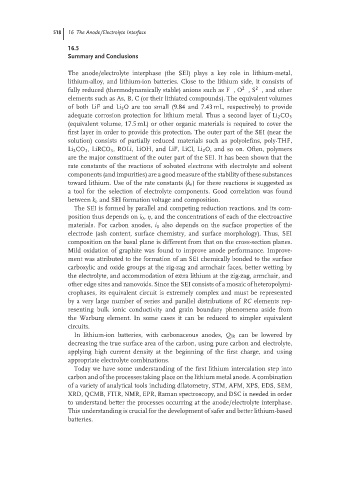Page 545 - Handbook of Battery Materials
P. 545
518 16 The Anode/Electrolyte Interface
16.5
Summary and Conclusions
The anode/electrolyte interphase (the SEI) plays a key role in lithium-metal,
lithium-alloy, and lithium-ion batteries. Close to the lithium side, it consists of
2−
−
2−
fully reduced (thermodynamically stable) anions such as F ,O ,S , and other
elements such as As, B, C (or their lithiated compounds). The equivalent volumes
of both LiF and Li 2 O are too small (9.84 and 7.43 mL, respectively) to provide
adequate corrosion protection for lithium metal. Thus a second layer of Li 2 CO 3
(equivalent volume, 17.5 mL) or other organic materials is required to cover the
first layer in order to provide this protection. The outer part of the SEI (near the
solution) consists of partially reduced materials such as polyolefins, poly-THF,
Li 2 CO 3 , LiRCO 3 , ROLi, LiOH, and LiF, LiCl, Li 2 O, and so on. Often, polymers
are the major constituent of the outer part of the SEI. It has been shown that the
rate constants of the reactions of solvated electrons with electrolyte and solvent
components (and impurities) are a good measure of the stability of these substances
toward lithium. Use of the rate constants (k e ) for these reactions is suggested as
a tool for the selection of electrolyte components. Good correlation was found
between k e and SEI formation voltage and composition.
The SEI is formed by parallel and competing reduction reactions, and its com-
position thus depends on i 0 , η, and the concentrations of each of the electroactive
materials. For carbon anodes, i 0 also depends on the surface properties of the
electrode (ash content, surface chemistry, and surface morphology). Thus, SEI
composition on the basal plane is different from that on the cross-section planes.
Mild oxidation of graphite was found to improve anode performance. Improve-
ment was attributed to the formation of an SEI chemically bonded to the surface
carboxylic and oxide groups at the zig-zag and armchair faces, better wetting by
the electrolyte, and accommodation of extra lithium at the zig-zag, armchair, and
other edge sites and nanovoids. Since the SEI consists of a mosaic of heteropolymi-
crophases, its equivalent circuit is extremely complex and must be represented
by a very large number of series and parallel distributions of RC elements rep-
resenting bulk ionic conductivity and grain boundary phenomena aside from
the Warburg element. In some cases it can be reduced to simpler equivalent
circuits.
In lithium-ion batteries, with carbonaceous anodes, Q IR can be lowered by
decreasing the true surface area of the carbon, using pure carbon and electrolyte,
applying high current density at the beginning of the first charge, and using
appropriate electrolyte combinations.
Today we have some understanding of the first lithium intercalation step into
carbon and of the processes taking place on the lithium metal anode. A combination
of a variety of analytical tools including dilatometry, STM, AFM, XPS, EDS, SEM,
XRD, QCMB, FTIR, NMR, EPR, Raman spectroscopy, and DSC is needed in order
to understand better the processes occurring at the anode/electrolyte interphase.
This understanding is crucial for the development of safer and better lithium-based
batteries.

